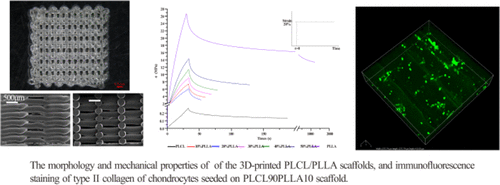Our official English website, www.x-mol.net, welcomes your feedback! (Note: you will need to create a separate account there.)
Blending with Poly(l-lactic acid) Improves the Printability of Poly(l-lactide-co-caprolactone) and Enhances the Potential Application in Cartilage Tissue Engineering
ACS Omega ( IF 3.7 ) Pub Date : 2021-07-08 , DOI: 10.1021/acsomega.1c02190 Ruiping Duan 1 , Yimeng Wang 1 , Yiyun Zhang 1 , Ziqiang Wang 1 , Fuchong Du 1 , Bo Du 1 , Danning Su 1 , Lingrong Liu 1 , Xuemin Li 1 , Qiqing Zhang 1, 2
ACS Omega ( IF 3.7 ) Pub Date : 2021-07-08 , DOI: 10.1021/acsomega.1c02190 Ruiping Duan 1 , Yimeng Wang 1 , Yiyun Zhang 1 , Ziqiang Wang 1 , Fuchong Du 1 , Bo Du 1 , Danning Su 1 , Lingrong Liu 1 , Xuemin Li 1 , Qiqing Zhang 1, 2
Affiliation

|
Poly(l-lactide-co-caprolactone) (PLCL, 50:50) has been used in cartilage tissue engineering because of its high elasticity. However, its mechanical properties, including its rigidity and viscoelasticity, must be improved for compatibility with native cartilage. In this study, a set of PLCL/poly(l-lactic acid) (PLLA) blends was prepared by blending with different mass ratios of PLLA that range from 10 to 50%, using thermoplastic techniques. After testing the properties of these PLCL/PLLA blends, they were used to fabricate scaffolds by the 3D printing technology. The structures and viscoelastic behavior of the PLCL/PLLA scaffolds were determined, and then, the potential application of the scaffolds in cartilage tissue engineering was evaluated by chondrocytes culture. All blends demonstrate good thermal stability for the 3D printing technology. All blends show good toughness, while the rigidity of PLCL is increased through PLLA blending, and Young’s modulus of blends with 10–20% PLLA is similar to that of native cartilage. Furthermore, blending with PLLA improves the processability of PLCL for 3D printing, and the compression modulus and viscoelasticity of 3D-printed PLCL/PLLA scaffolds are different from that of PLCL. Additionally, the stress relaxation time (t1/2) of the PLCL/PLLA scaffolds, which is important for chondrogenesis, is dramatically shortened compared with the pure PLCL scaffold at the same 3D-printing filling rate. Consistently, the PLCL90PLLA10 scaffold at a 70% filling rate with much shorter t1/2 is more conducive to the proliferation and chondrogenesis of in vitro seeded chondrocytes accompanied by upregulated expression of SOX9 than the PLCL scaffold. Taken together, these results demonstrate that blending with PLLA improves the printability of PLCL and enhances its potential application, particularly PLCL/PLLA scaffolds with a low ratio of PLLA, in cartilage tissue engineering.
中文翻译:

与聚(l-乳酸)共混提高了聚(l-丙交酯-共-己内酯)的可印刷性并增强了在软骨组织工程中的潜在应用
聚(l-丙交酯-共-己内酯)(PLCL,50:50)因其高弹性已被用于软骨组织工程。然而,它的机械性能,包括其刚度和粘弹性,必须改进以与天然软骨相容。在本研究中,一组 PLCL/poly( l-乳酸)(PLLA)共混物是通过使用热塑性技术与不同质量比的 PLLA(范围为 10% 至 50%)共混来制备的。在测试了这些 PLCL/PLLA 混合物的特性后,它们被用于通过 3D 打印技术制造支架。确定了 PLCL/PLLA 支架的结构和粘弹性行为,然后通过软骨细胞培养评估了支架在软骨组织工程中的潜在应用。所有共混物都表现出良好的 3D 打印技术热稳定性。所有共混物都表现出良好的韧性,同时通过 PLLA 共混增加了 PLCL 的刚度,并且与 10-20% PLLA 共混物的杨氏模量与天然软骨的杨氏模量相似。此外,与 PLLA 混合提高了 PLCL 用于 3D 打印的可加工性,并且3D打印的PLCL/PLLA支架的压缩模量和粘弹性与PLCL不同。此外,应力松弛时间(在相同的 3D 打印填充率下,与纯 PLCL 支架相比,PLCL/PLLA 支架的t 1/2 ) 显着缩短,这对软骨形成很重要。与 PLCL 支架相比,具有 70% 填充率和更短t 1/2的 PLCL90PLLA10 支架更有利于体外接种的软骨细胞的增殖和软骨形成,伴随着 SOX9 的上调表达。综上所述,这些结果表明,与 PLLA 混合提高了 PLCL 的可印刷性并增强了其潜在应用,尤其是具有低 PLLA 比例的 PLCL/PLLA 支架在软骨组织工程中。
更新日期:2021-07-20
中文翻译:

与聚(l-乳酸)共混提高了聚(l-丙交酯-共-己内酯)的可印刷性并增强了在软骨组织工程中的潜在应用
聚(l-丙交酯-共-己内酯)(PLCL,50:50)因其高弹性已被用于软骨组织工程。然而,它的机械性能,包括其刚度和粘弹性,必须改进以与天然软骨相容。在本研究中,一组 PLCL/poly( l-乳酸)(PLLA)共混物是通过使用热塑性技术与不同质量比的 PLLA(范围为 10% 至 50%)共混来制备的。在测试了这些 PLCL/PLLA 混合物的特性后,它们被用于通过 3D 打印技术制造支架。确定了 PLCL/PLLA 支架的结构和粘弹性行为,然后通过软骨细胞培养评估了支架在软骨组织工程中的潜在应用。所有共混物都表现出良好的 3D 打印技术热稳定性。所有共混物都表现出良好的韧性,同时通过 PLLA 共混增加了 PLCL 的刚度,并且与 10-20% PLLA 共混物的杨氏模量与天然软骨的杨氏模量相似。此外,与 PLLA 混合提高了 PLCL 用于 3D 打印的可加工性,并且3D打印的PLCL/PLLA支架的压缩模量和粘弹性与PLCL不同。此外,应力松弛时间(在相同的 3D 打印填充率下,与纯 PLCL 支架相比,PLCL/PLLA 支架的t 1/2 ) 显着缩短,这对软骨形成很重要。与 PLCL 支架相比,具有 70% 填充率和更短t 1/2的 PLCL90PLLA10 支架更有利于体外接种的软骨细胞的增殖和软骨形成,伴随着 SOX9 的上调表达。综上所述,这些结果表明,与 PLLA 混合提高了 PLCL 的可印刷性并增强了其潜在应用,尤其是具有低 PLLA 比例的 PLCL/PLLA 支架在软骨组织工程中。









































 京公网安备 11010802027423号
京公网安备 11010802027423号